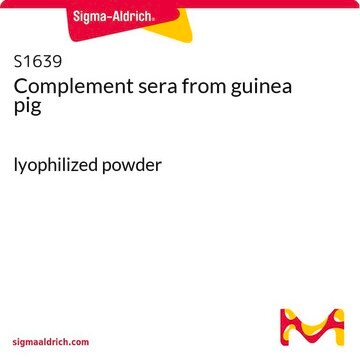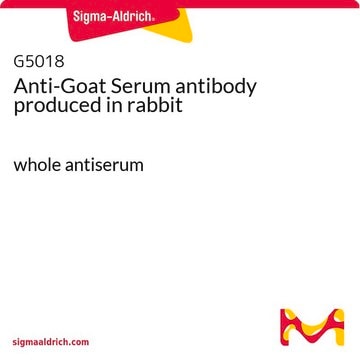P3164
Anti-Pig Serum antibody produced in rabbit
whole antiserum
Synonym(s):
Anti-Serum, pig
Sign Into View Organizational & Contract Pricing
All Photos(1)
About This Item
Recommended Products
biological source
rabbit
conjugate
unconjugated
antibody form
whole antiserum
antibody product type
primary antibodies
clone
polyclonal
contains
15 mM sodium azide
species reactivity
pig
technique(s)
immunoelectrophoresis: suitable
shipped in
dry ice
storage temp.
−20°C
target post-translational modification
unmodified
General description
Guinea pig serum is highly enriched with L-asparaginase activity. This L-asparaginase activity imparts inhibitory or anti-lymphoma effects to pig serum.
Specificity
Strong reactivity with normal pig serum has been determined.
Application
Anti-Pig Serum antibody produced in rabbit has been used in differential staining.
Anti-Pig Serum antibody produced in rabbit has been used in the dual differential staining of blastocysts to assess the number of inner cell mass (ICM) cells and trophectoderm (TE) cells.
Quality
The antiserum has been treated to remove lipoproteins.
Physical form
Rabbit Anti-Pig Serum is provided as a liquid containing 0.1% sodium azide as preservative.
Storage and Stability
For extended storage, the solution may be frozen in working aliquots. Repeated freezing and thawing is not recommended. Storage in "frost-free" freezers is not recommended. If slight turbidity occurs upon prolonged storage, clarify the solution by centrifugation before use.
Disclaimer
Unless otherwise stated in our catalog or other company documentation accompanying the product(s), our products are intended for research use only and are not to be used for any other purpose, which includes but is not limited to, unauthorized commercial uses, in vitro diagnostic uses, ex vivo or in vivo therapeutic uses or any type of consumption or application to humans or animals.
Not finding the right product?
Try our Product Selector Tool.
Storage Class Code
13 - Non Combustible Solids
WGK
WGK 1
Flash Point(F)
Not applicable
Flash Point(C)
Not applicable
Personal Protective Equipment
dust mask type N95 (US), Eyeshields, Gloves
Certificates of Analysis (COA)
Search for Certificates of Analysis (COA) by entering the products Lot/Batch Number. Lot and Batch Numbers can be found on a product’s label following the words ‘Lot’ or ‘Batch’.
Already Own This Product?
Find documentation for the products that you have recently purchased in the Document Library.
Customers Also Viewed
Tao Lin et al.
Reproductive toxicology (Elmsford, N.Y.), 75, 96-109 (2017-12-17)
In this study, we used a pig model to investigate the effects of α-solanine (a natural toxin found mainly in potato sprouts) on oocyte maturation, quality and subsequent embryonic development. We found that α-solanine (10 μM) disturbed meiotic resumption and increased
Ling Sun et al.
Journal of animal science and technology, 66(4), 726-739 (2024-08-21)
This study was conducted to investigate whether lysophosphatidic acid (LPA) could improve the development of porcine somatic cell nuclear transfer (SCNT) embryos. Porcine SCNT-derived embryos were cultured in chemically defined polyvinyl alcohol (PVA)-based porcine zygote medium (PZM)-4 without or with
Potential functional roles of follistatin on bovine somatic cell nuclear transfer embryos
Lee KB, et al.
Korean Journal of Agricultural Science, 40(4), 353-358 (2013)
alpha-Solanine impairs oocyte maturation and quality by inducing autophagy and apoptosis and changing histone modifications in a pig model.
Lin T, et al.
Reproductive Toxicology, 75, 96-109 (2018)
Tao Lin et al.
Reproductive biology, 16(4), 269-278 (2016-10-22)
The aim of this study is to investigate whether endoplasmic reticulum (ER) stress attenuation could improve porcine somatic cell nuclear transfer (SCNT) embryo developmental competence. We treated porcine SCNT embryos with TUDCA (tauroursodeoxycholic acid, an inhibitor of ER stress) and/or
Our team of scientists has experience in all areas of research including Life Science, Material Science, Chemical Synthesis, Chromatography, Analytical and many others.
Contact Technical Service











